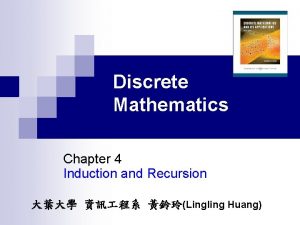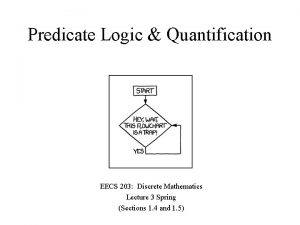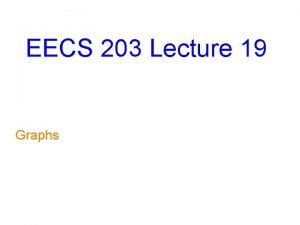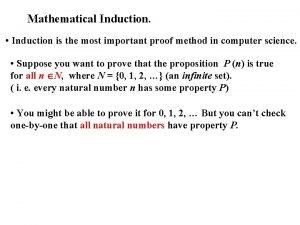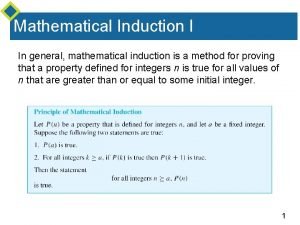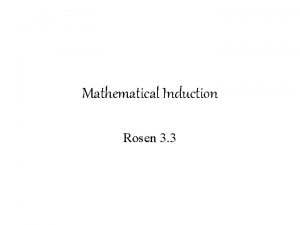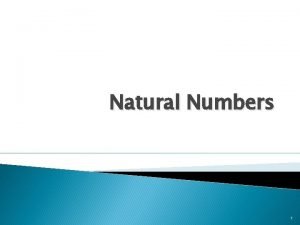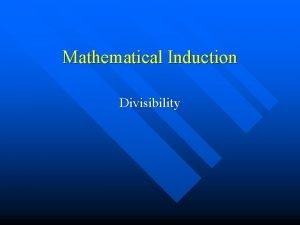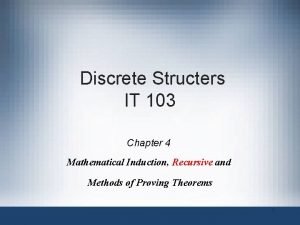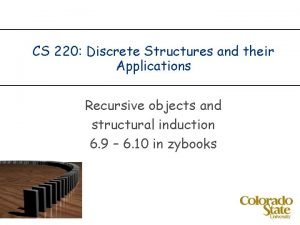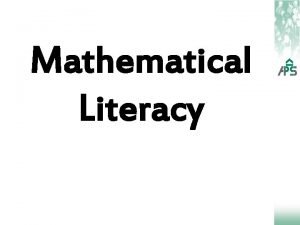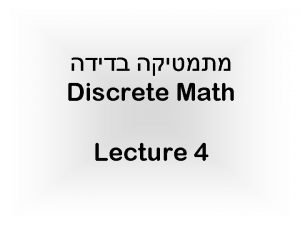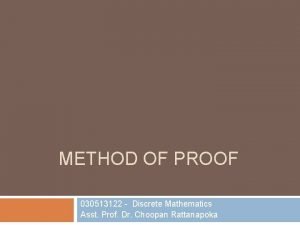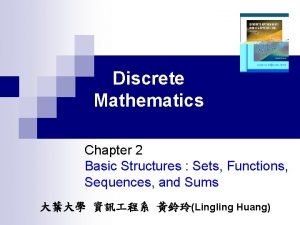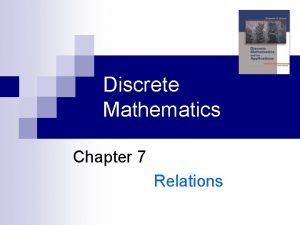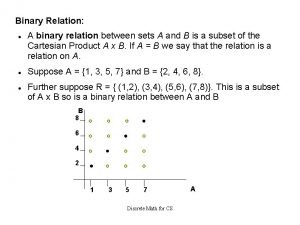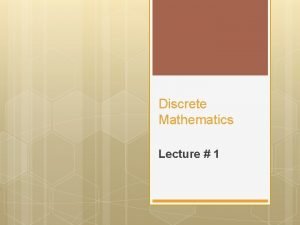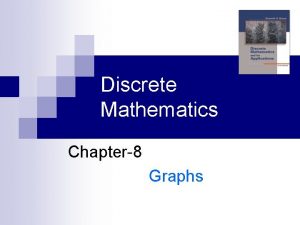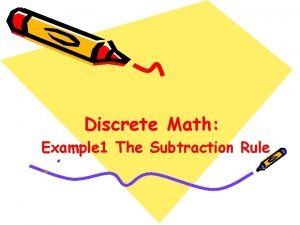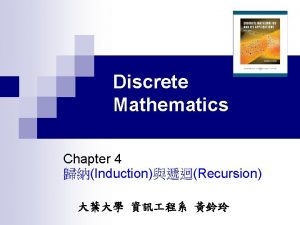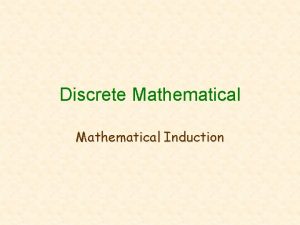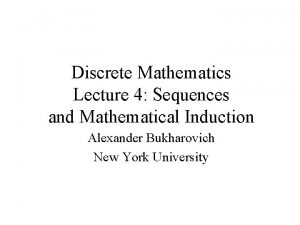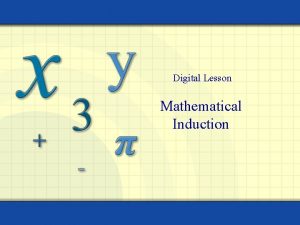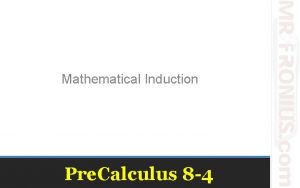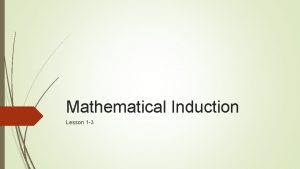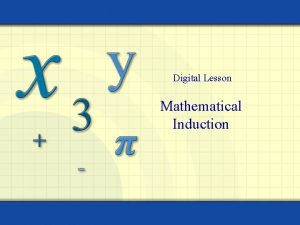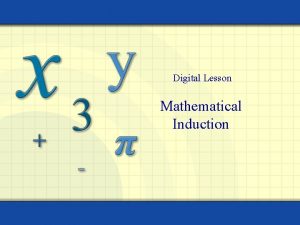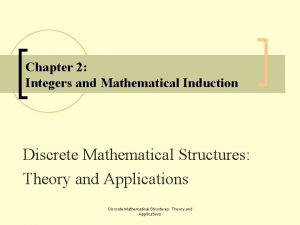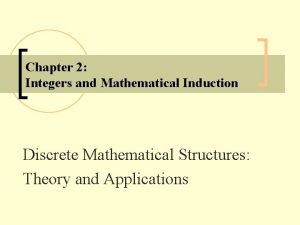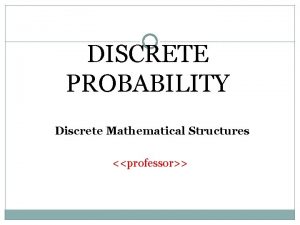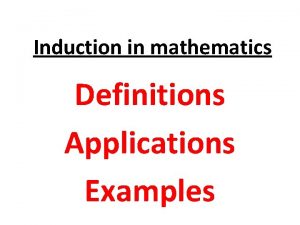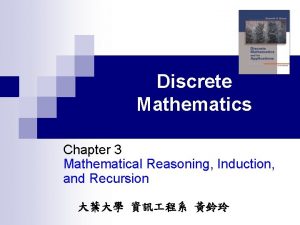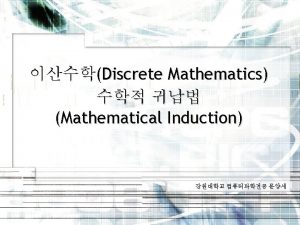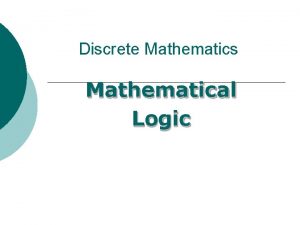Mathematical Induction EECS 203 Discrete Mathematics Lecture 11





























- Slides: 29

Mathematical Induction EECS 203: Discrete Mathematics Lecture 11 Spring 2016 1

Climbing the Ladder • We want to show that ∀n≥ 1 P(n) is true. – Think of the positive integers as a ladder. – 1, 2, 3, 4, 5, 6, . . . • You can reach the bottom of the ladder: – P(1) • From each ladder step, you can reach the next. – P(1) → P(2), P(2) → P(3), . . . – ∀k≥ 1 P(k) → P(k+1) • Then, by mathematical induction: – ∀n≥ 1 P(n) 2

Mathematical Induction • How do we prove a universal statement about the positive integers: ∀n≥ 1 P(n) • Mathematical induction is an inference rule – Base case: P(1) – Inductive step: ∀k≥ 1 P(k) → P(k+1) – Conclusion: ∀n≥ 1 P(n) • The inductive step requires proving an implication. 3

Simple Math Induction Example • Prove, for all n ∈ N, • Proof: We use induction. Let P(n) be: • Base case: P(0), because 0 = 0. 4

Simple Math Induction Example • Inductive step: Assume that P(k) is true, where k is an arbitrary natural number. 5

Simple Math Induction Example • Inductive step: Assume that P(k) is true, where k is an arbitrary natural number. • The first equality follows from P(k), and the second by simplification. Thus, P(k+1) is true. • By induction, P(n) is true for all natural numbers n. QED – This shows how to write a clear inductive proof. 6

Question • Did you understand the proof by induction? – (A) Yes, that’s really clever! – (B) How can you start with P(0) instead of P(1)? – (C) When do you use P(k) and when P(n)? – (D) Isn’t it circular to assume P(k), when you are trying to prove P(n)? – (E) I just don’t get it. 7

Divisibility Example (1) • Let’s try to prove ∀n∈N 3 | n 3−n. – First, we’ll work through the mathematics. – Then we’ll structure a clear proof. • Base case: P(0) is easy: 3 | (03− 0) – Everything divides zero, so it’s true. 8

Divisibility Example (2) • Inductive step: ∀k∈N P(k) → P(k+1) – Assume P(k): 3 | (k 3−k) (for arbitrary k) – Can we prove P(k+1): 3 | ((k+1)3 – (k+1)) ? • Try multiplying it out: • We know that 3 | (k 3−k) and 3 | (3 k 2+3 k). • Conclude that 3 | ((k+1)3 – (k+1)), so P(k) → P(k+1). 9

A Clear Divisibility Proof • • Theorem: ∀n∈N 3 | (n 3−n) Proof: Use induction on P(n): 3 | (n 3−n). Base case: P(0) is true because 3 | (03− 0). Inductive step: Assume P(k), for arbitrary natural number k. Then: • The final statement is P(k+1), so we have proved that P(k) → P(k+1) for all natural numbers k. • By mathematical induction, P(n) is true for all n∈N. 10 • QED

• Notice: we had to go back and start by assuming P(k) and then showing it implied P(k+1). – That first step isn’t at all clear unless you’ve done the math first! 11

• • Theorem: Proof: Base case: Inductive step: 12

A False “Proof” • 13

False “Proof” (2) • Inductive hypothesis P(k): In any set of k horses, all have the same color. • Now consider a set of k+1 horses – h 1, h 2, . . . hk, hk+1 • By P(k), the first k horses are all the same color – h 1, h 2, . . . hk, • Likewise, the last k horses are also the same color – h 2, . . . hk, hk+1 • Therefore, all k+1 horses must have the same color • Thus, ∀k∈N P(k) → P(k+1) • So, ∀n∈N P(n). What’s wrong? 14

Question • What’s wrong with that proof by induction? – (A) Mathematical induction doesn’t apply to horses. – (B) The Base Case is incorrect. – (C) The Inductive Step is incorrect. – (D) The Base Case and Inductive Step are correct, but you’ve put them together wrong. – (E) It’s completely correct: all horses are the same color! 15

The Problem with the Horses • Inductive step: ∀k∈N P(k) → P(k+1) – Now consider a set of k+1 horses • h 1, h 2, . . . hk, hk+1 – By P(k), the first k horses are all the same color • h 1, h 2, . . . hk, – Likewise, the last k horses are also the same color • h 2, . . . hk, hk+1 – Therefore, all k+1 horses must have the same color A set of one horse with the same color Another set of one horse with the same color 16

The Problem with the Horses • 17

The Problem with the Horses • Inductive step: ∀k∈N P(k) → P(k+1) – Now consider a set of k+1 horses • h 1, h 2, . . . hk, hk+1 – By P(k), the first k horses are all the same color • h 1, h 2, . . . hk, – Likewise, the last k horses are also the same color • h 2, . . . hk, hk+1 – Therefore, all k+1 horses must have the same color 18

The Problem with the Horses • Inductive step: ∀k∈N P(k) → P(k+1) – Now consider a set of k+1 horses • h 1, h 2, . . . hk, hk+1 – By P(k), the first k horses are all the same color • h 1, h 2, . . . hk, – Likewise, the last k horses are also the same color • h 2, . . . hk, hk+1 – Therefore, all k+1 horses must have the same color A group of two 19

The Problem with the Horses • Inductive step: ∀k∈N P(k) → P(k+1) – Now consider a set of k+1 horses • h 1, h 2, . . . hk, hk+1 – By P(k), the first k horses are all the same color • h 1, h 2, . . . hk, – Likewise, the last k horses are also the same color • h 2, . . . hk, hk+1 – Therefore, all k+1 horses must have the same color Another group of two 20

The Problem with the Horses • Inductive step: ∀k∈N P(k) → P(k+1) – Now consider a set of k+1 horses • h 1, h 2, . . . hk, hk+1 – By P(k), the first k horses are all the same color • h 1, h 2, . . . hk, – Likewise, the last k horses are also the same color • h 2, . . . hk, hk+1 – Therefore, all k+1 horses must have the same color But base step wasn’t true! 21

Tiling a Checkerboard (1) • For n≥ 1, consider a 2 n× 2 n checkerboard. • Can we cover it with 3 -square L-shaped tiles? No. • Remove any one of the squares. Can we tile it now? • Prove by induction: Let P(n) be the proposition: – A 2 n× 2 n checkerboard, minus any one of the squares, can be tiled with these L-shaped tiles. 22

Tiling a Checkerboard (2) • Consider a 2 k+1× 2 k+1 checkerboard, minus any one square. – Divide the checkerboard into four 2 k× 2 k quadrants. • The missing square is in one quadrant. – From the other three quadrants, remove the square closest to the center of the checkerboard. 23

Tiling a Checkerboard (3) • P(k) says that each quadrant (minus one square) can be tiled. One tile covers the three central squares. • Thus, P(k) → P(k+1), for arbitrary k≥ 1. • By mathematical induction, ∀n≥ 1 P(n). 24

The Harmonic Series (1) • The Harmonic Numbers are the partial sums of the Harmonic Series: • We want to prove that: • This implies an important property of the Harmonic Series: 25

The Harmonic Series (2) • Theorem: • Proof: By induction, with P(n) being • Base case: P(0) is true because • Inductive step: The inductive hypothesis P(k) is • From that assumption, we want to prove P(k+1). 26

The Harmonic Series (3) • The inductive hypothesis P(k) is • This demonstrates P(k+1). 27

The Harmonic Series (4) • This proves that P(k) P(k+1) for arbitrary k. • Therefore, by mathematical induction, P(n) is true for all n N. QED. – Theorem: • Let j = 2 n be some integer. Then n = log j. – Therefore, the Harmonic series diverges, because – But it diverges very slowly. 28

Prove that 6 divides n 3 − n whenever n is a nonnegative integer. 29
 Induction and recursion discrete mathematics
Induction and recursion discrete mathematics Induction math
Induction math Eecs 203
Eecs 203 Eecs 203
Eecs 203 Induction proof
Induction proof Mathematical induction
Mathematical induction Geometric sequence closed form
Geometric sequence closed form Strong induction
Strong induction Natural nubers
Natural nubers Principle of mathematical induction
Principle of mathematical induction Mathematical induction divisibility
Mathematical induction divisibility Mathematical induction
Mathematical induction Induksi matematika
Induksi matematika Which geometric series converges?
Which geometric series converges? Structural induction discrete math
Structural induction discrete math Elements of mathematical economics
Elements of mathematical economics Difference between mathematics and mathematical literacy
Difference between mathematics and mathematical literacy Total function definition
Total function definition Pqqpq
Pqqpq Basics of counting in discrete mathematics
Basics of counting in discrete mathematics Boolean function in discrete mathematics
Boolean function in discrete mathematics Onto function definition
Onto function definition Relations and digraphs in discrete mathematics
Relations and digraphs in discrete mathematics Dijkstra algorithm in discrete mathematics
Dijkstra algorithm in discrete mathematics What is binary relation
What is binary relation Declarative statement in discrete mathematics
Declarative statement in discrete mathematics Isomorphism of graphs in discrete mathematics
Isomorphism of graphs in discrete mathematics Subtraction rule counting
Subtraction rule counting Discrete mathematics chapter 1
Discrete mathematics chapter 1 Well formed formula
Well formed formula
